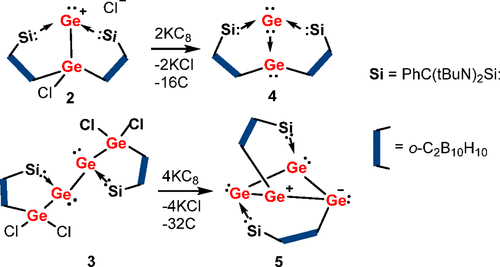New Types of Ge2 and Ge4 Assemblies Stabilized by a Carbanionic Dicarborandiyl-Silylene Ligand

The first Ge(0)–Ge(II) germylone–germylene-paired Ge2 complex (LSi)2Ge2 (4) and the molecular Ge4 cluster (LSi)2Ge4 (5) supported by the chelating carbanionic ortho-C,C′-dicarborandiyl-silylene ligand LSi [L = C,C′-C2B10H10, Si = PhC(tBuN)2Si] have been synthesized and isolated via reduction of the corresponding precursors chlorogermyl-germyliumylidene chloride (2), [(LSi)2Ge(Cl)Ge]+Cl–, and (LSi)2Ge4Cl4 (3) with C8K, respectively. The latter precursors were obtained from the unexpected outcome of the reaction of the ortho-C,C′-dicarborandiyl phosphine-silylene ligand PLSi (1) {P = P[N(tBu)CH2]2} and GeCl2·dioxane. Compound 2 is formed in higher yields (65% yields) by the salt metathesis reaction of the C-lithium dicarborandiyl-C′-silylene salt LiLSi (6) [Li = Li(OEt2)2] with GeCl2·dioxane. The molecular structures of all these species (1–6) have been established and confirmed spectroscopically and crystallographically. The electronic structures of 4 and 5 were elucidated by density functional theory calculations. While 4 possesses a localized dative Ge(0)→Ge(II) bond, the Ge–Ge σ bonds in 5 are delocalized in the Ge4 cluster core. Featuring a donor–acceptor interaction between two chelating silylenes and the Ge4 core, compound 5 represents a unique molecular model for a Ge4 cluster.
